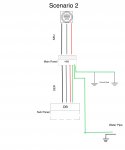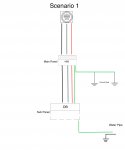- Occupation
- Licensed Electrician
I'm not picking on you but I will use your post as more evidence why I am solidly against this trend in the electrical industry and the NEC to use the word bonding instead of grounding and equipment grounding.I had my own question about this. I’ve always thought the ground rods were doing the “grounding” and the reason for running the wire to the pipe was “bonding“ so that the pipes are at the same potential as the rods and lightning will not travel through the dirt and up into the house and through the pipes.
In a situation with a main panel and a sub panel, is it ok to run a wire from the sub panel ground bus because it makes sense geographically (in cases where sub panel is closer to water pipe) or must the pipe be connected to the main panel where the neutral/ground bond occurs?
As far as connecting a water pipe that qualifies as a grounding electrode it has to be bonded at the service, 250.24. You can jumper from one electrode to the next as long as your wires are sized appropriately 250.64, 250.68.


